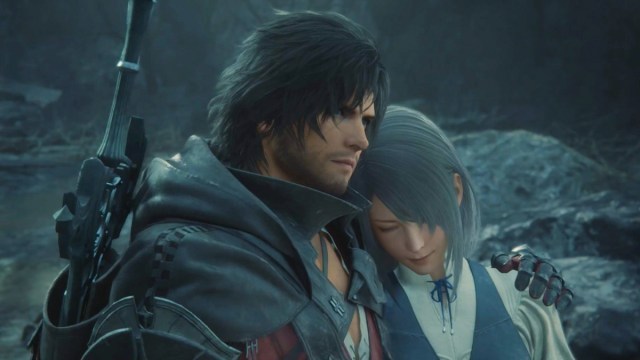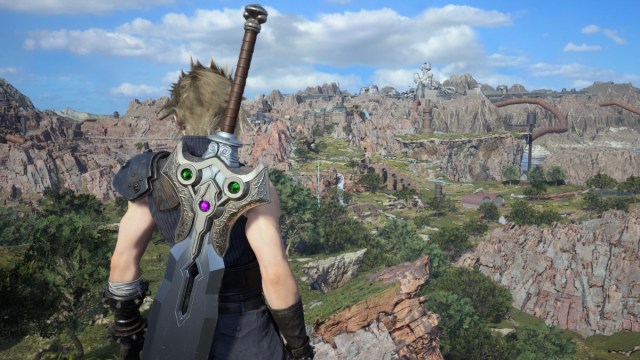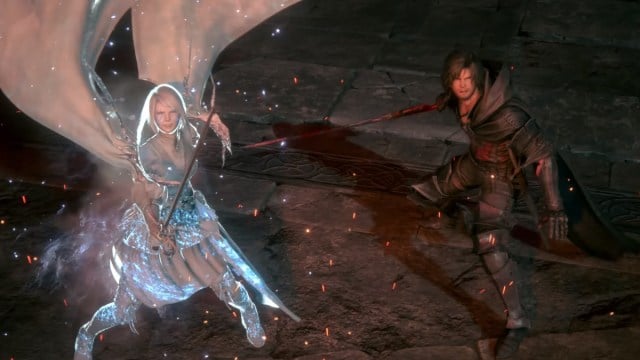It’s not every day two genre-defining RPGs release back to back, but it’s even rarer to see two top-caliber Final Fantasy games release within a year of each other. And yet, that’s exactly what’s happened with Final Fantasy VII Rebirth and Final Fantasy XVI.
This, of course, has led many to ask which is the better Final Fantasy game. Even if they have very different themes and tones, they’re still the exemplars of the series’ current trajectory and what we can expect from it moving forward.
That’s why we’re here to do just that and pit both games against each other in several categories. When the dust settles, you can rest assured that you’ll know which Final Fantasy title is most worth your time (at least in our opinion).
Story and Narrative

Final Fantasy has always been hailed for its stories and narratives, but the latest games really pull out all the stops to make theirs the best around.
Final Fantasy XVI delves into decidedly darker territory with a story inspired by Game of Thrones and other darkly realistic fantasy epics. An attempt is made to examine the ramifications of a world run by magic, and how social norms would emerge around the treatment of those capable of unleashing otherworldly powers at a moment’s notice.
Admittedly, it’s still not a perfect execution. The story never fully digs into these themes the way you’d want them to, and it forgoes them completely by the end of the game for a more standard tale of crystals, celestial entities, and saving the world. Still, though, it’s an earnest attempt to try something new with the franchise and feels satisfying when all is said and done.
Final Fantasy VII Rebirth, meanwhile, retells a tale fans know all too well; or at least, it retells part of it. Picking up after the events of Final Fantasy VII Remake, it digs into Cloud and his party’s pursuit of Sephiroth and their eventual discovery of his true motivations.
Simultaneously, it offers some new elements in the form of Zack’s adventures in an alternate timeline and its eventual collision with the main timeline’s events. This new material isn’t always laid out clearly though, and can feel overwhelming when it’s dumped on the player late into the game. It’ll almost certainly make more sense when the next game in the Remake trilogy releases though, and is a welcome addition to the FF7 mythos.
Winner: Final Fantasy XVI
When compared against each other, however, Final Fantasy XVI comes out on top. It more effectively introduces its new elements to the series’ storytelling, and manages to weave a coherent narrative without needing several other games to prop it up. Not only that, but it offers a new direction that future entries can explore as opposed to retreading ideas that have already been explored ad-nauseum.
Main Cast & Characters

Up next are the characters players spend their playthroughs with, and both titles take decidedly different approaches to how they present their stellar casts.
Final Fantasy XVI is decidedly more minimal with its characters and cast. The main party usually consists of three core characters via Clive, Jill, and Torgal, and other characters like Cid and Joshua rotate in as the story allows. This keeps the character building intimately focused on the core characters, which does admittedly make for some more personal narrative growth moments.
At the same time, however, there are plenty of engaging moments created through the supporting cast. Whether it’s the politically savvy Benedikta or the tragic last days of Cid, the characters players meet as their playthrough progresses keep the world feeling lived in and full of life.
Then, there’s Final Fantasy VII Rebirth, which arguably takes the opposite approach. The main party is loaded with different characters, all of which are given time to shine and interact with each other. Granted, most of these interactions happen with Cloud as a centerpiece, but they still allow the core cast to feel like fully fleshed-out characters.
The supporting cast is a little less fleshed out, but still just as interesting. Players can spend time with the bombastic Gold Saucer owner Dio, the multi-talented Shinra Middle Manager, or the many Queen’s Blood players scattered throughout the world, and they all serve to make the overall experience better with every scene they’re in.
Winner: Final Fantasy VII Rebirth
Bigger isn’t always better, but it’s hard not to give this one to Final Fantasy VII Rebirth. Its cast is bursting with oddballs players can’t resist spending time with, and they all make the overall game a joy to take part in for its many hours.
Visuals and Presentation

To say both of the most recent Final Fantasy games are visually stunning would be a massive understatement.
Final Fantasy XVI leans more into top-notch lighting and particle effects. All of its Eikons, whether one is talking about the fiery Ifrit or the gargantuan Titan, are always aglow in ethereal sparks and magical elements, and this remains true all the way through the experience. The battles are filled with fantastical attacks that feel like they could leap off the screen, and really sell the visceral nature of each landed hit.
The rest of the game’s visuals are just as impressive. Character models can be minutely detailed, with realistic facial movements and small effects like scars or blemishes rendered beautifully. The environments offer realistic depictions of lush forestry and bustling cityscapes alike, and further immerse players into any part of the story.
Final Fantasy VII Rebirth offers much the same, but with opposite focuses to its counterpart. The bulk of its efforts go into the character models and environments, which pop with a kind of hyper-realism that melds with its fantasy setting. One can truly get invested in the dramatic story moments thanks to the painstakingly crafted facial animations for Cloud, Aerith, and Sephiroth, and the amount of effort put into bringing every setting to life can leave players enraptured.
The combat and particle effects are still jaw-droppingly gorgeous though, and help the moment-to-moment gameplay feel all the more impactful. It just feels a bit more functional than stunning, and fades into the background compared to everything else.
Winner: Final Fantasy XVI
We have to give this one to Final Fantasy XVI. Its visual presentation feels more well rounded compared to Final Fantasy VII Rebirth, and it offers a better feast for the eyes as a result.
World & Side Content

When it comes to the world and the side content on offer, there’s arguably the biggest gap between these two titles.
On one hand, there’s Final Fantasy XVI, which has a very interesting new setting on offer. The world of Valisthea and its novel approach to Eikons makes for a great backdrop, and each chance one gets to further examine its cultures is a splendid opportunity. This helps to drive the player to explore as much of the world as possible and to learn all they can about its many characters and people.
Sadly, its side content is far from must-play material. Most of its side quests boil down to fetch quests that provide small bits of lore as a reward, which can get grating after nearly 100 hours in the game.
Counter to that, Final Fantasy VII Rebirth provides players with a massive world that sits just outside of Shinra’s direct influence. The cramped and dirty passageways and corridors of the Sectors are replaced with a massive open world to explore, complete with different villages and settlements which each feel unique from each other in key ways.
Not only that, but there’s meaningful side content to distract you for hours on end. The side quests offer opportunities to deepen Cloud’s relationship with his party members, and are varied enough to all feel different from each other. The World Intel tasks can serve as good ways to break up the open world travel when taken in moderation, and the plethora of minigames serve to break up even the most dire segments with some levity.
Winner: Final Fantasy VII Rebirth
This one handily goes to Final Fantasy VII Rebirth. It revels in the chance to give players plenty of moments to see the corners of its world and makes it endlessly fun to do so.
Combat & Gameplay

While it might seem like there’s a clear winner in this category, the contest is far from a simple one.
To be sure, Final Fantasy XVI is the game with the faster and more dynamic combat system. Akin to Devil May Cry or Bayonetta, it offers players a wide variety of moves and techniques they can use in quick succession to tear their opponents apart sans-turn-based combat elements.
The Summon fights are also a key part of the game, and they don’t disappoint. While they are filled to the brim with wild anime-esque scenes of massive monsters leaping to and fro like zero-G gymnasts, there’s also a sense of weight and impact that helps to sell the feeling that you’re battling with — and as — titanically massive monsters of myth.
As for Final Fantasy VII Rebirth, it retains the gameplay style of Final Fantasy VII Remake. Combat skews toward a mix of turn-based and active gameplay, which allows for both hack-and-slash brawls and carefully orchestrated bombardments with abilities and magic.
While this might sound more slow and methodical than its competition’s gameplay, there’s actually plenty of room for creativity. One can slash and tear their way through foes rapidly via hot-keyed moves and abilities, which makes it possible to pull off moves just as insane as those seen in Final Fantasy XVI.
And it’s still more than possible to opt for a turn-based approach too. One can choose to turn on a mode which makes it possible to give orders to the game’s characters as the battle progresses, turning the game into a highly cinematic exchange between the player and the enemy.
Winner: Tie
This category is a bit too close to call. Both games offer the same style of innovation to the series’ tried and true turn-based combat, but in very different ways that still work great all the same. As such, either one could take home the win.
Audio & Voice Acting

Finally, there’s the audio and voice acting, and both titles give it their all in these areas.
Final Fantasy XVI’s soundtrack is dire and bombastic, with melancholy tunes for its more dramatic moments and intense pieces to go along with the world-ending clashes between its Eikons. Both are used masterfully, and bolster the moments they’re used in to truly sell the stakes or emotional impact of each scene.
The voice acting follows suit, with performances that can range from Oscar-worthy to right at home in the climax of an action movie. Particular kudos goes to Clive’s voice actor Ben Starr, who carries the game with his many line deliveries and impressive range no matter the scene.
Final Fantasy VII Rebirth is equally impressive. Its voice acting can be a little more erratic due to its larger roster of characters, but everyone gives solid performances that don’t ever pull the player too far out of whatever they’re doing.
The game’s soundtrack, however, is unmatched. Nailing a variety of tones, it both revels in the themes of the original Final Fantasy VII and reinvents them in new and interesting ways. The result is a treasure trove of themes and songs which are not only perfect accompaniments to the game but stand out as amazing tunes in their own right.
Winner: Final Fantasy VII Rebirth
Even though Final Fantasy XVI has the better voice acting, Final Fantasy VII Rebirth’s soundtrack sets it apart as the better game in terms of audio design. Its OST will be on many a player’s playlist for months and years to come, and it deserves all the accolades possible for that fact.
Overall Winner: Final Fantasy VII Rebirth

The contest was a close one, but Final Fantasy VII Rebirth is the better Final Fantasy game in our eyes. It captures the magic of the series at its best, and nails key areas that any truly great entry in the franchise needs. If you have to pick between the two games, Rebirth is hands-down the one to try out first. Once that’s done, give the other a look to cover your bases and revel in what is easily a new golden age of Final Fantasy.













